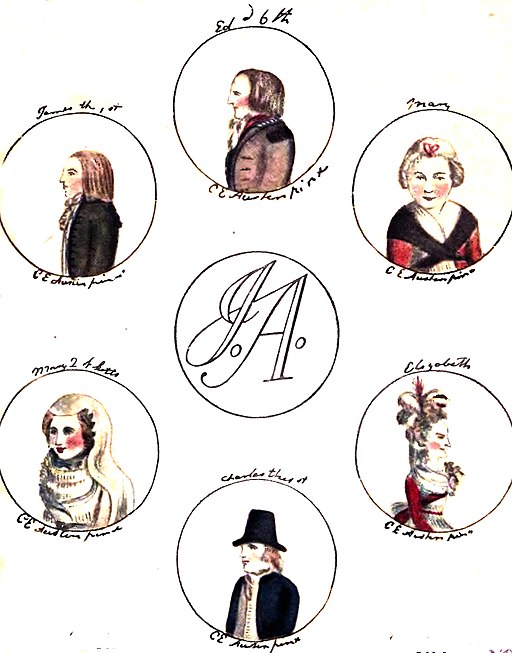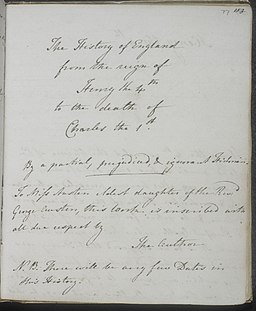
“The History of England” by Jane Austen was written when the author was fifteen years old in 1791. The work is a humorous work that pokes fun at widely used school history books of the time.
The manuscript of thirty-four pages is in Jane Austen’s hand. Thirteen watercolor miniatures accompany it by her elder sister, Cassandra. The notebook is today preserved in the British Library collection.
In “The History of England,” Austen mockingly imitates the style of textbook histories of English monarchs, while ridiculing school history books’ pretensions to objectivity.
The title page of Austen’s manuscript reads:
“The History of England
from the reign of
Henry the 4th
to the death of
Charles the 1st
By a partial, prejudiced, & ignorant Historian.”
The work is dedicated to Austen’s sister Cassandra with:
“To Miſs Austen, eldest daughter of the Revd
George Austen, this work is inscribed with
all due respect by
The Author”
Jane Austen’s history book has very few dates and cites as sources works of fiction such as:
- the plays of Shakespeare
- plays of Sheridan
- a novel by Charlotte Turner Smith
- and the opinions of Austen’s family and friends.

Title Page of Austen’s Manuscript
The accounts of English kings and queens contain comically exaggerated opinions about their characters and behavior. Austen enjoyed embellishing the stories with charades and puns on names.
While the work offered humorous vignettes on English Kings, significant attention is paid to the royal women, such as:
- Anne Boleyn,
- Lady Jane Grey,
- and Mary Queen of Scots.
Jane Austen’s version of “The History of England” rebalanced the insufficiency of attention to female figures in school history books.
Mary Queen of Scots, in particular, plays an essential role in Austen’s History, receiving more generosity in her portrayal than her cousin Elizabeth I, who is treated as a tyrant.
Some years later, Austen compiled this work and 28 other writings of her early compositions by copying them into three notebooks, which she called “Volume the First,” “Volume the Second,” and “Volume the Third.”
These notebooks still exist, one in the Bodleian Library and the other two in the British Library. These three volumes are considered Austen’s Juvenilia.
None of Austen’s youthful works were published in her lifetime. Cassandra’s 13 illustrations were done after the copying was completed.
“The History of England” has more recently been included in editions of Jane Austen’s complete works and has been published in several new publications and imprints.

Vignettes of early Kings of England by Cassandra Austen for her sister Jane Austen’s comedic “History of England.”
Jane Austen Juvenilia (1787–1793)
From at least the age of eleven, Austen wrote poems and stories for her family’s amusement. In these works, the details of life are exaggerated, and established plot devices are parodied.
The stories are full of stories of female agency and general high spirits. Austen compiled copies of twenty-nine works written between 1787 and 1793 into three bound notebooks, now referred to as the Juvenilia.
Among these works is a satirical novel titled “Love and Freindship,” in which she mocked popular novels of Sensibility.
When Austen was around eighteen years old, she began to write longer, more sophisticated works with the aspiration of becoming a professional writer.
Love and Freindship
“Love and Freindship” is a story by Jane Austen, at 15 years of age. Written in epistolary form as letters from the heroine, to the daughter of her friend.
The form may have come about due to the nightly readings by the young Jane to the Austen family.
The story with the title intentionally misspelled is a parody of romantic novels that Austen read. This approach is clear from the subtitle:
“Deceived in Freindship and Betrayed in Love.”
The story featured wild coincidences and turns of fortune, but Austen was parodying the conventions of romantic stories. The story shows the development of Austen’s wit and disdain for romantic Sensibility.
Jane Austen
Jane Austen (1775 – 1817) was known for novels, which interpret, critique, and comment upon the British landed gentry at the end of the 18th century.
Her six significant novels include:
- Sense and Sensibility (1811),
- Pride and Prejudice (1813),
- Mansfield Park (1814)
- Emma (1816),
- Northanger Abbey and Persuasion were both published posthumously (1818).
Her six novels have rarely been out of print, although they were published anonymously and brought her moderate success and little fame during her lifetime.
Austen novels have inspired many films, critical essays, and literary anthologies.
“The History of England” by Jane Austen
- Title: “The History of England” by Jane Austen
- Date: 1791
- Culture: English
- Type: Historically Influential Books and Manuscripts
- Museum: British Library
“The History of England” by Jane Austen
Virtual Tour of the British Library
- Theatrum Orbis Terrarum
- Constitution of the Athenians by Aristotle
- “Newton after Blake” by Eduardo Paolozzi
- The Beowulf Manuscript – Nowell Codex
- Lindisfarne Gospels
- Gutenberg Bible
- Magna Carta
- “The History of England” by Jane Austen
The History of England by Jane Austen
Virtual Tour of Ancient Texts
- Gilgamesh Flood Tablet – 7th century BCE
- Lament for Ur – 1800 BC
- Law Code of Hammurabi – 1754 BC
- Book of the Dead – Papyrus of Ani and Hunefe – 1250 BCE
- Cyrus Cylinder – 539–538 BC
- The Rosetta Stone – 196 BC
- Constitution of the Athenians by Aristotle – 100
- Vindolanda Tablets – 1st-century
- Codex Vaticanus – 300–325
- Vienna Dioscurides – Juliana Anicia Codex – 515
- Lindisfarne Gospels – 715-720
- Beowulf – Nowell Codex – 975–1025
- Blue Qur’an – 9th – 10th century
- Miroslav Gospel – 1186
- Magna Carta – 1215
- Hadith Bayad wa Riyad – 13th-century
- The Belles Heures of Jean of France, Duke of Berry – 1405
Jane Austen: Behind Closed Doors
Virtual Tour of Historically Influential Books
- Gutenberg Bible – 1450
- Code Noir – 1687
- “Common Sense” by Thomas Paine – 1766
- “Poems on Various Subjects, Religious and Moral” by Phillis Wheatley – 1766
- “The History of England” by Jane Austen – 1791
- Gardner’s Photographic Sketchbook of the Civil War – 1863
- Ancient Texts and Historically Influential Books
Jane Austen Country: The Life & Times of Jane Austen
Jane Austen’s “A History of England”- Performed
Jane Austen Country
~~~
“In vain have I struggled. It will not do. My feelings will not be repressed. You must allow me to tell you how ardently I admire and love you.”
― Jane Austen, Pride And Prejudice
~~~
Photo Credit: 1)Jane Austen / Public domain; Cassandra Austen (signed "CE Austen") / Public domain
Popular this Week








 Sponsor your Favorite Page
Sponsor your Favorite Page SEARCH Search for: Search Follow UsJoin – The JOM Membership Program
Sponsor a Masterpiece with YOUR NAME CHOICE for $5
Share this:
- Tweet
